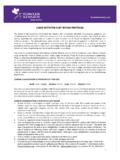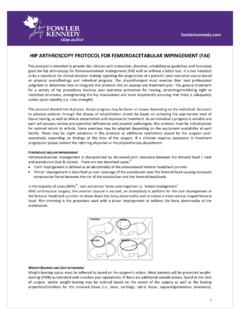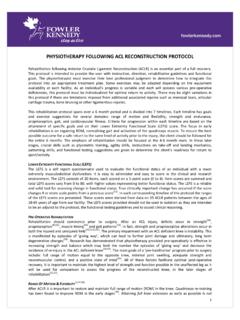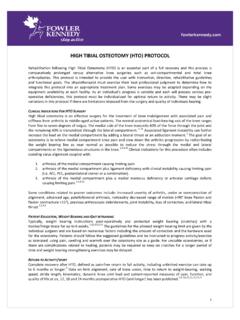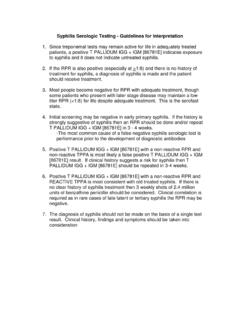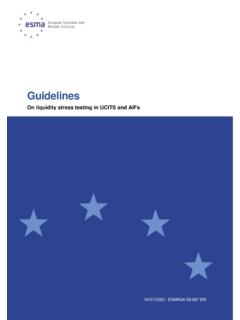Transcription of Functional Testing Guidelines for ACL Reconstruction
1 1 Functional Testing Guidelines FOR ACL Reconstruction Testing INSTRUCTIONS FOR CLINICIANS Carioca Quickly side step with the lead leg followed by the trail leg crossing in front of the lead on the first step and then behind on the second step for a straight distance of 30 feet and immediately reverse the direction to cover the same distance in the shortest possible time (at or full speed depending on stage). Tuck Jump Feet should be positioned shoulder width apart and the athlete will be asked to repeatedly jump for 10 seconds, pulling their thighs up parallel to the ground, while the clinician scores the quality of the performance for each of the 8 categories by circling a number on a scale from 0 (never) - 10 (always). The scores in each category are summed to provide the total for the assessment (out of 80). Two trials can be performed (one viewing from the front, one viewing from the side) to attain scores for all 8 categories.
2 A horizontal line of tape can be used as the target for jumping and landing in the same location. Hop Tests x 4 General: Running shoes are to be worn. 1. Perform tests in the order they appear. 2. One practice trial is given for each limb. Two measurements are taken and the average is recorded. 3. No restrictions are given on arm movement. 4. Begin with non-operated leg. 5. Two alternating trials on both limbs are measured and means for each are recorded 6. Start with lead toe behind marked line. 7. Measurement is taken to either the nearest 10th of a second (stopwatch) or nearest 10th of a centimetre (measuring tape). 8. A failed jump consists of loss of balance, touching the floor with arms or opposite leg, or an additional short hop on landing. 9. To calculate "Limb Symmetry Index" values, average the two-recorded trials on each limb; divide the operative limb average by the non-operative limb average, and multiply by 100 (percentage).
3 Once "Limb Symmetry Index" values are calculated for each of the 4 hop tests, the average of these is taken for the "Overall Combination" score. 1. Single leg hop for distance Stand on one limb and hop as far forward as possible, landing on the same limb. Maintain the landing for a minimum of 2 seconds while the toe measurement is recorded. (measured to the nearest cm) 2. Single leg 6 m timed hop Perform large one-legged hops in series over 6 metres. (timed to nearest 10th of a second) 3. Triple hop for distance Perform 3 successive hops as far as possible and land on the same leg. Maintain the final landing for a minimum of 2 seconds while the toe measurement is recorded. (measured to nearest 10th of a cm) 4. Crossover hop for distance Perform 3 hops as far as possible crossing over a 15cm wide strip marking on each hop and maintain landing after the 3rd hop for 2 seconds. The first of the 3 hops is lateral with respect to the direction of the crossover.
4 (measured to the nearest 10th of a cm) 2 Single Leg 8-inch Jump Landing Stand on one leg and perform a jump landing off a 8-inch box. The landing must be held for 5 seconds with balance maintained. The entire sequence is to be completed with good mechanics, including proper landing stance, knees flexed and in line with foot, level pelvis, and vertical alignment of trunk. Single Leg Vertical Jump for Height Stand sideways on one leg, unsupported, next to a wall. Bend your knees and jump as high as possible, tap your hand on the wall at the maximum vertical height. One practice trial is given for each limb. Perform two alternating trials on the unaffected and affected sides. The vertical height is measured and the averages recorded for the L and R legs. 3 STAGE 1: 6-9 Week s Post-Op LEFS Score: _____ P4 Score: _____ Hold or Progress (circle one) RANGE OF MOTION Non-Operative (R / L) Operative (R / L) Flexion (125 +) Hold / Progress Extension (0 ) Hold / Progress QUADS TONE (Circle one) Hold / Progress Poor (unable) Fair ( cont n, VM tone) Good (cont n, VM tone) Excellent (= opposite VM) QUADS LAG (Sitting Leg Extension) Hold / Progress No Yes Measure Lag:_____( ) * *Lag: i) capsular if passive extension (see ROM) ii) muscular if full passive extension STROKE TEST(swelling) (Circle one) Hold / Progress Zero Trace (small wave medial side with downstroke) 1+ (larger bulge medial side with downstroke) 2+ (effusion spontaneously returns to medial side) 3+ (so much fluid, not possible to move effusion out of medial aspect) (Sturgill et al.
5 2009) LEG CIRCUMFERENCE Non-Operative ( R / L ) Operative ( R / L ) Hold / Progress Medial joint line (cm) If operative side is > cm in circumference = joint swelling (Whitney et ) 2 LEGGED SQUAT (70 ) Non-Operative ( R / L ) Operative ( R / L ) Hold / Progress 20% difference (lbs.) (using 2 bathroom scales) SINGLE LEG STANCE Non-Operative ( R / L ) Operative ( R / L ) Eyes Open (30 sec) Hold / Progress Eyes Closed (30 sec) Hold / Progress 4 STAGE 2: 16-20 Weeks Post-Op LEFS Score: _____ P4 Score: _____ Hold or Progress (circle one) SINGLE LEG SQUAT (60 ) Hold / Progress 5 second hold with good balance Yes No Good mechanics Yes No Good mechanics: head up, knee in line over foot, level pelvis, trunk in midline and vertical AGILITY DRILL: CARIOCA (@ speed) Hold / Progress Compensatory movements? (Hip hike, knee flexion in air, altered weight-bearing) Yes No Adequate speed/patterning?
6 Yes No Apprehension? Yes No Complaints of pain? Yes No Comments: PLYOMETRIC DRILL: 10 sec TUCK JUMP (1st Measurement) (Myer, 2006) Hold / Progress Knee and Thigh Motion SCORE 1. Knees neutrally aligned at landing 0 1 2 3 4 5 6 7 8 9 10 2. Thighs reach parallel (observed at highest point of jump) 0 1 2 3 4 5 6 7 8 9 10 3. Thighs equal side-to-side (throughout sequence) 0 1 2 3 4 5 6 7 8 9 10 Foot Position 4. Foot placement shoulder width apart 0 1 2 3 4 5 6 7 8 9 10 5. Foot placement not staggered (side view) 0 1 2 3 4 5 6 7 8 9 10 6. Toe-to-midfoot rocker utilized (no heel strike) 0 1 2 3 4 5 6 7 8 9 10 Plyometric Technique 7. Rapid rebound between jumps (no visible delay) 0 1 2 3 4 5 6 7 8 9 10 8. Lands in same footprint (from point of take off) 0 1 2 3 4 5 6 7 8 9 10 Total for Assessment: /80 5 *Allow 2 trials to attain scoring in all 8 categories *Tuck Jump scoring system: 1.
7 Reliability not published, pilot data only r= (range: ) 2. ii) not validated to date on any population (Myer et al. 2006) STAGE 2: 16-20 Weeks Post-Op (continued) HOP Testing (Baseline Measurement) (Reid, 2007) Hold / Progress Single Hop For Distance Non-operative Limb (cm) Operative (cm) Limb Symmetry Index 1. 2. 1. 2. 6-m Timed Hop Non-operative Limb (sec) Operative (sec) Limb Symmetry Index 1. 2. 1. 2. Triple Hop For Distance Non-operative Limb (cm) Operative (cm) Limb Symmetry Index 1. 2. 1. 2. Crossover Hop For Distance Non-operative Limb (cm) Operative (cm) Limb Symmetry Index 1. 2. 1. 2. Overall combination of hop tests: See hop Testing instructions for scoring (page 1) Assessor's Signature: Date: 6 STAGE 3: 24-36 Weeks Post-Op LEFS Score: _____ P4 Score: _____ Hold or Progress (circle one) SINGLE LEG 8-inch JUMP LANDING Hold / Progress Able to land with 5 second hold?
8 Yes No Good body mechanics? (ball-midfoot landing, knees flexed, pelvis level, trunk midline) Yes No Complaints of pain? Yes No Comments: VERTICAL JUMP FOR HEIGHT Hold / Progress Vertical Height (cm) Trial 1 / 2 Average Height Non-operavtive Limb (R/L) / Operative Limb (R / L) / AGILITY DRILL: CARIOCA (@ full speed) Hold / Progress Compensatory movements? (Hip hike, knee flexion in air, altered WB) Yes No Adequate speed/patterning? Yes No Apprehension? Yes No Complaints of pain? Yes No Comments: PLYOMETRIC DRILL: 10 sec TUCK JUMP (2nd Measurement) (Myer, 2006) Hold / Progress Knee and Thigh Motion SCORE 1. Knees neutrally aligned at landing 0 1 2 3 4 5 6 7 8 9 10 2. Thighs reach parallel (observed at highest point of jump) 0 1 2 3 4 5 6 7 8 9 10 3.
9 Thighs equal side-to-side (throughout sequence) 0 1 2 3 4 5 6 7 8 9 10 Foot Position 4. Foot placement shoulder width apart 0 1 2 3 4 5 6 7 8 9 10 5. Foot placement not staggered (side view) 0 1 2 3 4 5 6 7 8 9 10 6. Toe-to-midfoot rocker utilized (no heel strike) 0 1 2 3 4 5 6 7 8 9 10 Plyometric Technique 7. Rapid rebound between jumps (no visible delay) 0 1 2 3 4 5 6 7 8 9 10 8. Lands in same footprint (from point of take off) 0 1 2 3 4 5 6 7 8 9 10 Total for Assessment: /80 7 STAGE 3: 24-36 Weeks Post-Op (continued) HOP Testing (Second measurement) (Reid, 2007) Hold / Progress Single Hop For Distance Non-Operative Limb (cm) Operative (cm) Limb Symmetry Index 1. 2. 1. 2. 6-m Timed Hop Non-Operative Limb (sec) Operative (sec) Limb Symmetry Index 1. 2. 1. 2.
10 Triple Hop For Distance Non-Operative Limb (cm) Operative (cm) Limb Symmetry Index 1. 2. 1. 2. Crossover Hop For Distance Non-Operative Limb (cm) Operative (cm) Limb Symmetry Index 1. 2. 1. 2. Overall combination of hop tests: See hop Testing instructions for scoring (page 1) Assessor's Signature: Date: Direct correspondence to: M. Werstine HBSc(Kin), BHSc(PT), Masters Manip Ther (AUS), MSc, FCAMT Fowler Kennedy Sport Medicine Clinic Physiotherapy Department 3M Centre, UWO London, Ontario, Canada N6A 3K7 Phone: 519-661-2111 x88831 Fax: 519-661-3379
